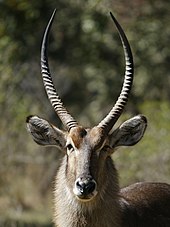Waterbuck

As water Bock two types of African antelopes from the kind of water blocks ( Kobus ), respectively. A distinction is made between the elliptical waterbuck ( Kobus ellipsiprymnus ) and the Defassa waterbuck ( Kobus defassa ). Both were originally combined in one species and, to distinguish them from the other species of the genus Kobus, also under the name of common waterbuck , today they are considered independent.
features
Elliptical waterbuck
The elliptical waterbuck ( Kobus ellipsiprymnus ) is a large, strong, up to 270 kg heavy antelope with shaggy, gray-brown fur and a white ring around the base of the tail (the eponymous ellipse). The face is also partially white, and a white stripe runs from the throat to the base of the ears. Only the males have long, strongly curled, widely curved horns pointing forward. The shoulder height is 1.30 m.
The distribution area extends from South Africa and northeast Namibia via Botswana and Mozambique and the savannas of East Africa to Ethiopia and Somalia .
This antelope species is tied to permanent water bodies, in the vicinity of which there are forests or open grassy areas overgrown with thickets and reeds . Young males form their own herds, females and young animals live together in groups of 5 to 10 animals.
Defassa waterbuck
The Defassa waterbuck ( Kobus defassa ) also has a shoulder height of 1.30 m. However, it usually wears a lighter coat than the elliptical waterbuck. Its fur is thick and longer than that of most other grazers, making it particularly noticeable in the hot climates of tropical Africa. The most noticeable difference to the elliptical waterbuck is that it has a white mirror at the base of its tail instead of the ellipse. Its distribution area extends in West and Central Africa from Senegal to Sudan and from there southwards via Congo to Angola .
Way of life
The two waterbuck species are less bound to water than other representatives of their genus. They can move away from the water and can then be found in the open savannah or in forests. The female waterbuck live in herds of about five, in rare cases up to seventy animals. Young males also form flocks. On the other hand, older males become loners who defend a territory against conspecifics and claim every passing female for herself.
Danger
Waterbuck are among the most common large mammals in Africa. It is estimated that there are around 95,000 Defassa waterbuck and 105,000 elliptical waterbuck, more than half of which live in protected areas. Both species are classified as near threatened by the IUCN . The populations outside of protected areas are declining due to hunting and habitat destruction.
Unusual
An unusual settlement of waterbuck took place in 1976 in the Calauit Game Preserve and Wildlife Sanctuary in the Philippines . It is the only wild population outside of Africa.
literature
- Colin P. Groves and David M. Leslie Jr .: Family Bovidae (Hollow-horned Ruminants). In: Don E. Wilson and Russell A. Mittermeier (eds.): Handbook of the Mammals of the World. Volume 2: Hooved Mammals. Lynx Edicions, Barcelona 2011, ISBN 978-84-96553-77-4 , pp. 680-682
Individual evidence
- ↑ Britta Meyer: Wildlife of special interest ( Memento from February 16, 2012 in the Internet Archive ) (PDF file, 87 kB, English)
- ↑ Kobus ellipsiprymnus in the endangered Red List species the IUCN 2012. Posted by: IUCN SSC Antelope Specialist Group, of 2008.
- ↑ Colin P. Groves and David M. Leslie Jr .: Family Bovidae (Hollow-horned Ruminants). In: Don E. Wilson and Russell A. Mittermeier (eds.): Handbook of the Mammals of the World. Volume 2: Hooved Mammals. Lynx Edicions, Barcelona 2011, ISBN 978-84-96553-77-4 , pp. 680-682
- ^ The Calauit Game Preserve and Wildlife Sanctuary. In: gov.ph. Palawan Council for Sustainable Development, accessed July 30, 2016 .


